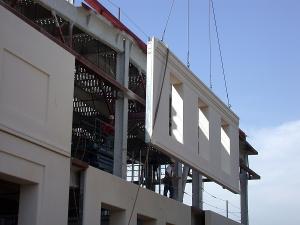The increasing demand for affordable housing and quick construction methods is boosting the adoption of precast concrete solutions.
NY, UNITED STATES, February 7, 2025 /EINPresswire.com/ -- The Precast Concrete Construction Market is experiencing significant growth, driven by increasing demand for durable, cost-effective, and sustainable building materials. Precast concrete, manufactured off-site and assembled on location, has revolutionized the construction industry by improving efficiency, reducing labor costs, and enhancing structural quality. With the rapid expansion of urbanization, infrastructure development, and technological advancements, the market for precast concrete construction is expected to witness steady growth in the coming years.Market Overview
Precast concrete refers to prefabricated concrete components that are produced in controlled environments and transported to construction sites for assembly. This method is widely used in residential, commercial, and industrial construction projects. The market includes precast elements such as walls, beams, columns, floors, and facades, offering numerous advantages over traditional on-site construction methods.
Precast Concrete Construction Market Size was estimated at 117.17 (USD Billion) in 2023. The Precast Concrete Construction Market Industry is expected to grow from 120.43(USD Billion) in 2024 to 150.0 (USD Billion) by 2032. The Precast Concrete Construction Market CAGR (growth rate) is expected to be around 2.78% during the forecast period (2025 - 2032).
Get a sample of the Report - https://www.wiseguyreports.com/sample-request?id=652432
Key Market Drivers
1. Urbanization and Infrastructure Development
The rise in urbanization, especially in developing regions, has fueled the demand for efficient construction solutions. Governments worldwide are investing in smart cities, transportation networks, and commercial infrastructure, creating a strong demand for precast concrete.
2. Cost and Time Efficiency
Precast concrete significantly reduces on-site labor and construction time. Since the components are manufactured in a controlled environment, weather-related delays are minimized, leading to faster project completion and cost savings.
3. Growing Focus on Sustainability
The construction industry is under increasing pressure to adopt environmentally friendly practices. Precast concrete reduces material wastage, optimizes resource utilization, and enhances energy efficiency, making it a preferred choice for green building initiatives.
4. Technological Advancements
The integration of Building Information Modeling (BIM), automation, and digitalization in precast concrete production has improved design precision, customization, and construction efficiency. 3D printing technology is also emerging as a game-changer in the sector.
5. Rising Demand for Resilient Structures
With the increasing occurrence of natural disasters, the demand for earthquake-resistant and weatherproof buildings has risen. Precast concrete structures offer superior strength and durability, making them ideal for high-risk areas.
Market Segmentation
1. By Product Type
Structural Building Components (columns, beams, walls, slabs)
Architectural Building Components (facades, decorative panels)
Transportation & Infrastructure Components (bridges, tunnels, railway sleepers)
Utility & Landscaping Components (pipes, septic tanks, street furniture)
2. By End-Use Sector
Residential (housing complexes, apartments)
Commercial (offices, malls, hotels)
Industrial (factories, warehouses, data centers)
Infrastructure (roads, bridges, airports, railways)
3. By Region
North America (United States, Canada)
Europe (Germany, France, UK, Italy)
Asia-Pacific (China, India, Japan, Southeast Asia)
Latin America (Brazil, Mexico)
Middle East & Africa (UAE, South Africa)
Buy Now - https://www.wiseguyreports.com/checkout?currency=one_user-USD&report_id=652432
Challenges and Restraints
1. High Initial Investment
Setting up precast concrete manufacturing facilities requires substantial capital investment in equipment, molds, and skilled labor. This can be a barrier for small and medium-sized enterprises.
2. Transportation and Logistics Issues
Transporting heavy precast concrete components to construction sites poses logistical challenges, especially in remote areas. The cost of transportation can impact overall project expenses.
3. Limited Design Flexibility
While precast concrete allows for customization, it has limitations compared to cast-in-place concrete, particularly for unique and complex architectural designs.
Market Trends
1. Modular Construction Boom
The increasing adoption of modular and prefabricated construction is fueling the demand for precast concrete elements, as they offer speed and efficiency.
2. Smart and Sustainable Building Solutions
Eco-friendly construction materials, including low-carbon concrete and recycled aggregates, are gaining traction, aligning with global sustainability goals.
3. Integration of Digital Technologies
BIM, AI-driven design optimization, and robotics in precast concrete production are improving precision, reducing material waste, and enhancing overall efficiency.
Future Outlook
The precast concrete construction market is expected to witness substantial growth over the next decade. Asia-Pacific is projected to be the fastest-growing region due to rapid urbanization, infrastructure expansion, and government initiatives promoting prefabricated building solutions. North America and Europe will continue to invest in sustainable and resilient construction practices, further boosting market demand.
WGR recognizes the following Precast Concrete Construction Companies - LafargeHolcim,Oldcastle Infrastructure,Boral,Gulf Precast,Tindall Corporation,Stanton Construction,Spancrete,CRH,Whatcom Concrete,CEMEX,Prefabrication and Modularization,Elematic,Future Infrastructure
The precast concrete construction market is poised for significant expansion, driven by urbanization, technological advancements, and a shift toward sustainable building materials. While challenges such as high initial costs and logistics constraints remain, continuous innovations and increasing adoption of digital construction methods will propel the market forward. As demand for efficient, durable, and eco-friendly construction solutions rises, precast concrete will play a pivotal role in shaping the future of the global construction industry.
Browse In-depth Precast Concrete Construction Market (200 Pages, Charts, Tables, Figures) - https://www.wiseguyreports.com/reports/precast-concrete-construction-market
Related Articles
Freight Forwarding Market - https://www.wiseguyreports.com/reports/freight-forwarding-market
Freight Forwarding Platform Market - https://www.wiseguyreports.com/reports/freight-forwarding-platform-market
Smart Building Glass Market - https://www.wiseguyreports.com/reports/smart-building-glass-market
Industrial Machinery Manufacturing Market - https://www.wiseguyreports.com/reports/industrial-machinery-manufacturing-market
Storage & Garage Organization - https://www.wiseguyreports.com/reports/garage-storage-organization-market
Scaffolding And Accessories Market - https://www.wiseguyreports.com/reports/scaffolding-and-accessories-market
Dimension Stone Mining Market - https://www.wiseguyreports.com/reports/dimension-stone-mining-market
WiseGuyReports (WGR)
WISEGUY RESEARCH CONSULTANTS PVT LTD
+1 628-258-0070
email us here
Legal Disclaimer:
EIN Presswire provides this news content "as is" without warranty of any kind. We do not accept any responsibility or liability for the accuracy, content, images, videos, licenses, completeness, legality, or reliability of the information contained in this article. If you have any complaints or copyright issues related to this article, kindly contact the author above.


